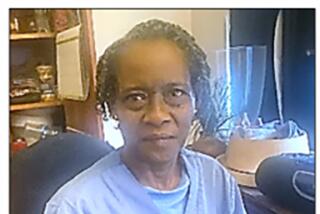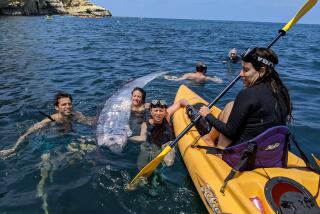Companion of Apparent Shark Victim Missing
OXNARD — A woman apparently killed by a great white shark off the coast here was identified Monday as a UCLA student on a kayaking excursion with her boyfriend, who is still missing, authorities said.
The two, both UCLA graduate students, had left Malibu Thursday for a morning of kayaking, said Ventura County Sheriff Lt. Lary Reynolds. Both one-person kayaks were found Friday five miles off the coast of Zuma Beach. One of the kayaks has three large holes that probably were punctures made by the teeth of a shark, Reynolds said.
Tamara McCallister, 24, of Mar Vista, was found Saturday about six miles off Channel Island Harbor in Oxnard by the crew of a sailboat.
Her companion, Roy Jeffrey Stoddard, 24, of Malibu, is a UCLA graduate student in epidemiology.
Randy Lee, who shared a Malibu beach house with Stoddard, said McCallister and Stoddard had dated for about a year. Both had evening classes at UCLA and frequently kayaked together in the morning.
On the day they disappeared, Lee said, they took muffins and coffee out to the beach, had breakfast and then took off for a short trip. They planned to paddle to Paradise Cove--about 1.5 miles away--and return.
“Roy knew there was a slow leak in his kayak, so there’s no way he was planning on going any farther than the cove,” Lee said. “It was just a short trip and they did it all the time. Roy wasn’t a reckless guy and he wouldn’t do anything that would put himself in jeopardy. So I really think this shark business took place around here and the currents brought them up the coast.”
Stoddard “really knew the ocean,” Lee said. He was an experienced scuba diver and surfer and had been kayaking more than five years.
After graduating from Pepperdine University in 1987 with honors, Stoddard, whose family lives in San Jose, entered graduate school at UCLA. He had recently applied for medical school, Lee said, and just received his first acceptance letter.
McCallister moved to Los Angeles from Portland, Ore., in September to study for a master’s degree in public health at UCLA, according to her mother, Linda McCallister. She had spent time in Africa, her mother said, and wanted to go back “to help people.”
“A beautiful girl, gone,” Linda McCallister said. “She had a big contribution to give. Some don’t, but she did.”
Her mother said she had tried to reach Tamara for several days to plan a visit to Los Angeles. “I have been calling for days,” Linda McCallister said. “I got concerned when she didn’t return my calls.”
The mother, who said she last saw Tamara at Christmas, called her daughter “an outdoors type.” She said Tamara and Stoddard “took a liking to each other” because of their mutual interest in the outdoors.
Laverne Dye, who had rented a room to McCallister in her Mar Vista home, said the UCLA student was an experienced kayaker, was extremely fit, and swam or ran every day.
Between 1926--when California officials began keeping such records--and 1984, six other people have been killed by sharks. In five of those attacks--including one off La Jolla in 1959--the shark was believed to be a great white. There have been 62 reported shark attacks in California in that same time period, less than 10% of them in Southern California.
Despite the shark attack, kayakers and surfers interviewed Monday said they do not intend to switch to more sedate sports.
At Surfer’s Point in Ventura, about 100 wave riders gathered Monday morning to surf before strong afternoon winds began to blow.
Paul Bradley, 26, said he didn’t even think of canceling his daily surfing session when he heard a radio account of the shark attack early Monday morning.
“There are always adverse conditions,” he said. “That’s what attracts people.”
Mark Olson of Santa Barbara, a member of the California Kayak Friends, a Southern California kayaking group, said he frequently kayaks in the area where the woman’s body was found.
“I’ll see a blue shark every once in a while,” he said. “And when I see one I realize it’s best to stay calm, rather than to change directions and start paddling real fast. Sharks are attracted by the sudden churning of water. It’s like you never run from a dog. They sense your fear and will come after you.”
Jerry Gorans, a surfer from Simi Valley, expressed little concern about the shark attack as he waxed his board at Malibu.
“It (the attack) might keep some people out of the water, but not many,” he said. “It’s just one of the things you live with when you go surfing.”
Tamara McCallister had been dead one to two days when her body was found Saturday off Channel Islands Harbor near Ventura by the crew of a sailboat, said F. Warren Lovell, Ventura County coroner. She had been bitten six times and died of loss of blood, Lovell said. Authorities believe the shark was a great white because of the size of the bite on her left thigh--about 13 inches.
John McCosker, one of California’s leading shark experts, warned that the area where the woman was believed to be kayaking has a high number of sharks because of an explosion in the seal and sea lion populations. As a result, attacks on humans who venture miles from the shoreline in light craft are “entirely predictable,” said McCosker, director of the Steinhart Aquarium in San Francisco.
The area in which the woman’s body was found has the heaviest concentration of sharks in Southern California, McCosker said, because it is near the Channel Islands, a large breeding ground for marine mammals.
“A lot of boat operators in that area are telling us about more and more shark attacks on sea lions and seals,” McCosker said. “So it follows that there are going to be more attacks on people out there. A shark looks up and sees a big silhouette from something like a kayak, thinks he’s got a big elephant seal and swims up to take it.”
Steve Abel, who holds the world record for biggest blue shark ever caught on a fly rod--140 pounds--landed his record catch adjacent to the Channel Islands, not far from where the woman’s body was recovered.
“On a day’s fishing out there I’ll see between 50 and 100 mako and blue sharks,” Abel said. “And they catch a great white shark pretty much every year around here.”
Corwin reported from Santa Barbara. Also contributing were staff writers Meg Sullivan in Ventura, John H. Lee in Malibu and Sebastian Rotella in Los Angeles.
More to Read
Sign up for Essential California
The most important California stories and recommendations in your inbox every morning.
You may occasionally receive promotional content from the Los Angeles Times.









